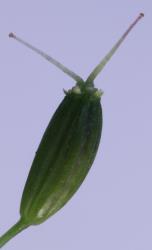- Taxon
- Gallery
Herbaceous, glabrous, gynodioecious perennial with stout fleshy taproots surmounted by slender upright stems invested with remains of older leaves at the base. Leaves 3–5 per rosette, imparipinnate, subcoriaceous; petiole terete, 7–30 cm long, 1.5–4.0 mm diam., grey-green, often flushed maroon in proximal part, sheath with marginal wings 3.0–4.5 × 12–45 mm; rachis 5–17 cm long, 1.0–5.5 mm diam., grey-green. Leaflets in 4– 7 pairs, often overlapping, sessile; 10–50 × 10– 55 mm, smaller distally, orbicular to rhomboid, grey-green, dense glaucous bloom on both surfaces; margin rounded in distal part with 12–44 teeth, teeth serrate, dentate, or crenate, 0.5–2.4 × 0.7–3.5 mm; base cuneate, obtuse, sometimes ± truncate, entire; apex obtuse. Inflorescences axillary, up to 4 per plant, 14–42 cm long, each with 1 terminal compound umbel and up to 6 lateral compound umbels, lateral umbels subtended by cauline leaves. Cauline leaves 12–60 mm long, grey-green, sheath 11–18 × 5.0–7.5 mm, leaflets in 1–4 pairs; lower cauline leaves similar in size to rosette leaves, with lobed or toothed leaflets; upper cauline leaves reduced in size, leaflets linear, usually entire or sparsely toothed. Compound umbel peduncle 27–85 mm long, each with 7–28 simple umbels; lateral umbels with fewer simple umbels and flowers than terminal umbel; 4–6 primary bracts at the base of each compound umbel, free, 5.5–13.0 × 2.0–3.8 mm, broad-elliptic, grey-green; apex narrowly acuminate, 5.0–6.0 mm long. Simple umbel peduncle 8–14 mm long, each with 4–23 flowers; 4–6 secondary bracts at the base of each simple umbel, usually slightly fused at base, 2.4–6.0 × 0.7–1.5 mm broad-elliptic, grey-green; apex acuminate, 1.4–2.3 mm long. Pedicels dimorphic: in female flower 1.5–3.3 mm long and stout, in male and hermaphrodite flowers 2.6–4.2 mm long and slender; sepals 0.5–0.7 × 0.3–0.4 mm, triangular, green; stylopodium up to 0.2 mm high, green; petals 1.1–1.3 × 1.1–1.3 mm, orbicular, spurred, white; styles divergent, flushed pink, 1.0–1.3 mm long in female flowers, 1.7–1.8 mm long in hermaphrodite flowers; stamens of male and hermaphrodite flowers recurved, 1.3–1.8 mm long, minute staminodes in female flowers; anthers 0.4–0.5 mm long, white. Carpophore 3.4–3.6 mm long. Mericarps 3.9–4.1 × 0.9–1.1 mm, ovate to ovateelliptic, brown, slightly flattened dorsally; dorsal surface with 5 ribs, lateral ribs winged, wings 0.4– 0.5 mm wide, base cordate; commisure with narrow, flat central ridge; vittae solitary between wings.
[Reproduced from Heenan (2004, New Zealand J. Bot. 42: 175-180) with permission from The Royal Society of New Zealand.]




